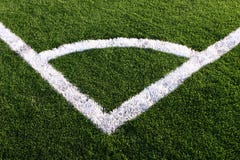A throw-in is taken when the ball crosses one of the touchlines and goes out of play. The team that kicked the ball out of play loses possession of the ball, and the other side gets to take a throw-in. During a throw-in, a designated player stands out of bounds and, as the name suggests, throws the ball back into play. This is the only time during play that a non-goalkeeper may touch the ball with their hands. Opposing players must stand at least two meters away from the player taking the throw-in. The player who throws the ball in cannot touch it again until it touches at least one other player (so they can't throw it to themselves). Lastly a player cannot score a goal by throwing the ball into the opposing net.
The throw-in has to be taken with two hands, it has to be thrown over the thrower's head, and the player making the throw has to face the pitch. You can't take a running start on a throw-in. The throw-in is taken from the point where the ball crossed the line; identifying this spot is one of the jobs of the assistant officials.
As with other game restarts, the team taking the throw is allowed to choose who does it. Most teams have at least one specialist whose job is to be good at throw-ins.
Law 16: Goal kicks
A goal kick is given when an attacking player puts the ball over the defending side's byline. This type of kick is almost exclusively taken by the defending team's goalkeeper. The player taking the kick can choose to place the ball wherever they wish within their own penalty area. It is for all intents and purposes otherwise a direct free kick, in that you can score on it, the ball is stationary, you can't stand too close, etc. The only thing to keep in mind is that once the ball is placed for the kick, the goalkeeper can't use their hands to touch it again until after it is kicked and then touched by another player.
Law 17: Corner kicks
A corner kick is given when a defending team puts the ball over their own byline. The ball is taken to one of the corners of the pitch (Whichever was closest to where the ball went over the line) and the attacking team gets a free kick from that corner. At each of the corners of the pitch there is an arc that looks like this:

The player taking the corner can put the ball anywhere within this arc. He then takes a run up to it and kicks it toward the goal. Usually his teammates will be standing near the goal in an attempt to take the corner and try and get it into the net for a goal. As with the other restart procedures, teams may choose whoever they like to take this type of kick, Corner kicks can be very dangerous, as it allows an attacking side to setup close to the goal and get a guaranteed pass in a scoring area. Teams that are big underdogs frequently try to defend near their own goal and then hope for corner opportunities to score for themselves.
A couple of last notes: Free kicks, throw-ins, corner kicks, and penalty kicks are collectively called set pieces. The reason for this is that they take place outside of the normal flow of the match, because they all cause a match stoppage that allows both sides to stop and setup however they'd like. For a team that is poor on scoring in the regular flow of a match, because their player or tactics are poor, set pieces provide scoring opportunities
Defending sides can also sometimes desire a set piece. If a defending team is caught on the wrong foot you'll sometimes see a defending player kick the ball out of bounds on purpose, because, while a set piece is dangerous, it might be less dangerous than allowing an attacking player a decent chance at goal.
And, that's it! Those are the 17 laws of the game. From here I plan alternating between articles about basic tactics, including the different positions and skills required to play them, and articles about how high-level soccer is structured, including how leagues work, how international competition works, etc.



No comments:
Post a Comment